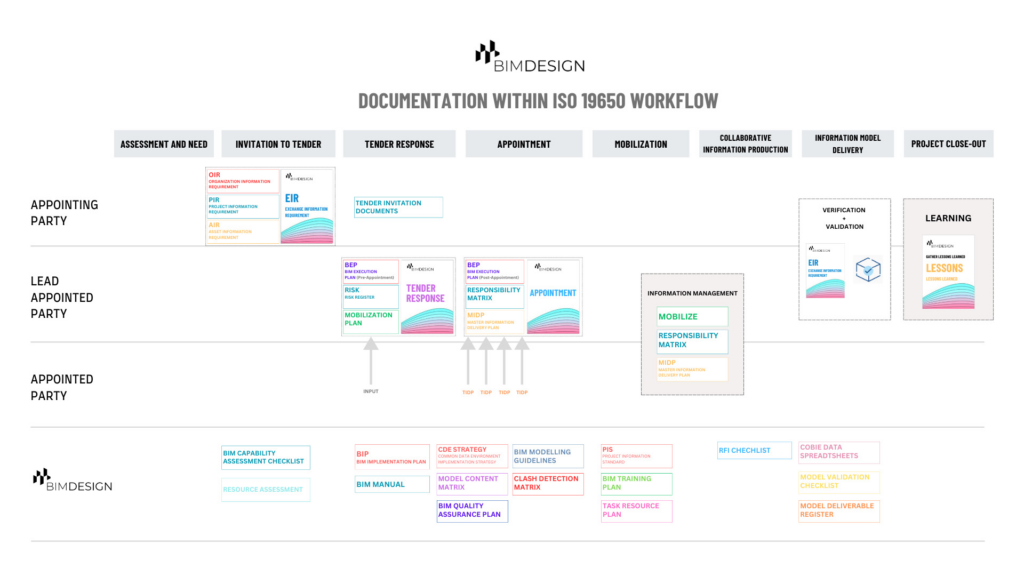
BIM DOCUMENTATION
Solving the Real Problems That Your Business Faces
Our BIM Documentation Services provide detailed and standardized project documentation that aligns with industry standards, including EIR (Employer’s Information Requirements), BEP (BIM Execution Plans), MIDP (Master Information Delivery Plans), and TIDP (Task Information Delivery Plans). We also prepare modeling guidelines, LOD specifications, QA/QC protocols, and COBie-compliant asset data for facility management.

Our BIM Documentation Workflow
1. Defining Information Requirements (OIR, PIR, EIR, AIR)
- Organizational Information Requirements (OIR):
- Define high-level business objectives and asset management strategies for BIM adoption.
- Identify long-term data needs for operational and facility management.
- Project Information Requirements (PIR):
- Establish project-specific BIM deliverables, model coordination strategies, and collaboration workflows.
- Define LOD (Level of Development), model validation criteria, and interoperability requirements.
- Exchange Information Requirements (EIR):
- Specify BIM-related expectations for design, construction, and handover phases.
- Define requirements for model content, software platforms, data formats (IFC, COBie), and CDE protocols.
- Asset Information Requirements (AIR):
- Outline information deliverables needed for facility management and operation.
- Define parameters for digital asset data, maintenance schedules, and lifecycle planning.
2. BIM Execution Plan (BEP) & Model Development Strategy
- Prepare a pre-contract BEP addressing:
- Project scope, roles, and responsibilities of stakeholders.
- Common Data Environment (CDE) structure and document management workflows.
- Interoperability and data exchange standards (IFC, DWG, NWC, Revit).
- Develop a post-contract BEP, including:
- Model structuring and work-sharing methodologies in Revit.
- LOD/LOIN matrix defining data richness for each project phase.
- Coordination procedures and clash resolution workflows in Navisworks.
- Establish audit and quality control protocols for model validation.
3. BIM Information Management Plan (MIDP/TIDP)
- Master Information Delivery Plan (MIDP):
- Defines who, when, and how BIM deliverables will be produced and shared.
- Aligns data drops, model updates, and coordination schedules.
- Task Information Delivery Plan (TIDP):
- Specifies individual team responsibilities for delivering BIM models and documents.
- Ensures discipline-specific alignment with MIDP schedules.
4. Model Development & LOIN Matrix Implementation
- Define the Level of Information Need (LOIN) matrix based on geometric detail (LOD) and data richness (LOI).
- Develop a Model Element Table (MET) specifying modeling responsibilities, accuracy levels, and required parameters.
- Ensure consistency in Revit family creation, naming conventions, and classification systems (Uniclass, Omniclass, COBie).
5. Common Data Environment (CDE) & Document Control
- Establish a structured CDE (Autodesk Construction Cloud, ProjectWise) for document sharing and version control.
- Define file naming conventions, metadata tagging, and access permissions.
- Implement revision tracking and approval workflows to ensure information accuracy.
Deliverables
Employer’s Information Requirements (EIR)
Defining BIM expectations and deliverables.
Organizational & Project Information Requirements (OIR/PIR)
High-level and project-specific BIM requirements.
Asset Information Requirements (AIR)
Outlining data needs for facility management.
BIM Execution Plan (BEP)
Defining standards, workflows, and modeling guidelines.
Master Information Delivery Plan (MIDP)
Scheduling BIM deliverables and updates.
Task Information Delivery Plan (TIDP)
Assigning responsibilities for BIM tasks.
Level of Information Need (LOIN) Matrix
Specifying model detail and data requirements.
Model Element Table (MET)
Defining responsibilities for model components.
Get in Touch With a Member of Our Team Today

